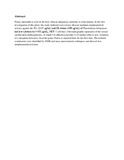| dc.contributor.author | Endale, M | |
| dc.contributor.author | Ekberg, A | |
| dc.contributor.author | Alao, JP | |
| dc.contributor.author | Akala, HM | |
| dc.contributor.author | Ndakala, A | |
| dc.contributor.author | Sunnerhagen, P | |
| dc.contributor.author | Erdélyi, M | |
| dc.contributor.author | Yenesew, A | |
| dc.contributor.author | Yenesew, Abiy | |
| dc.date.accessioned | 2013-10-30T07:46:12Z | |
| dc.date.available | 2013-10-30T07:46:12Z | |
| dc.date.issued | 2012-12 | |
| dc.identifier.citation | Molecules. 2012 Dec 27;18(1):311-21 | en |
| dc.identifier.uri | http://www.ncbi.nlm.nih.gov/pubmed/23271468 | |
| dc.identifier.uri | http://erepository.uonbi.ac.ke:8080/xmlui/handle/123456789/58037 | |
| dc.description.abstract | Pentas micrantha is used in the East African indigenous medicine to treat malaria. In the first investigation of this plant, the crude methanol root extract showed moderate antiplasmodial activity against the W2- (3.37 μg/mL) and D6-strains (4.00 μg/mL) of Plasmodium falciparum and low cytotoxicity (>450 μg/mL, MCF-7 cell line). Chromatographic separation of the extract yielded nine anthraquinones, of which 5,6-dihydroxylucidin-11-O-methyl ether is new. Isolation of a munjistin derivative from the genus Pentas is reported here for the first time. The isolated constituents were identified by NMR and mass spectrometric techniques and showed low antiplasmodial activities. | en |
| dc.language.iso | en | en |
| dc.publisher | University of Nairobi | en |
| dc.title | Anthraquinones of the roots of Pentas micrantha | en |
| dc.type | Article | en |
| local.publisher | Department of Chemistry | en |


